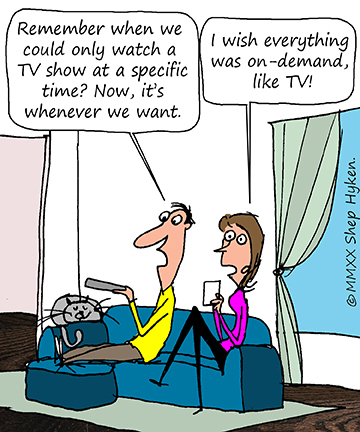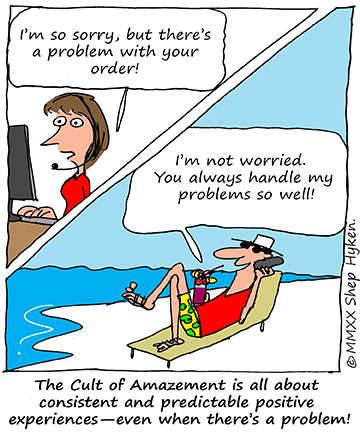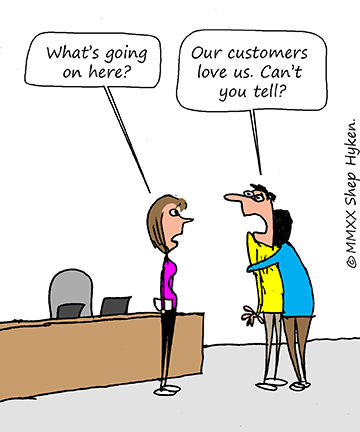Shep Hyken's Blog, page 110
February 28, 2020
Guest Post: What a CX Professional Can Learn from a Top Salesperson
This week we feature an article by Eric Melchor, founder of Elevate My CX. He shares a story about a salesperson who performed a technique that even surprised a renowned social psychologist.
If you’re a Customer Experience specialist, you might think that salespeople are not the kind of role models to get customer care tips from. In fact, you’re probably telling yourself – “Salespeople? I give them customer experience tips and insights, not the other way around.”
But you’d be surprised. There’s a lot you can learn from those whose day-to-day activity consists of building rapport and trust with potential customers.
Consider for example Jim, who was consistently the top-performing salesperson at a fire alarm system company. Jim didn’t win every sale, who does, but he always outperformed his counterparts. He did this by performing a technique that you wouldn’t find in any sales training book or case studies on the best sales techniques. It was a technique that even surprised the renowned social psychologist Robert Cialdini who has written books about the psychology of influence.
Want to know what that technique is?
When Cialdini accompanied Jim to learn how he approached the selling process, Cialdini discovered how Jim accomplished an aura of trust with potential customers that he had never seen before. And he did it by pretending to be a bit of a screwup. Here’s how:
Before Jim began his sales pitch, he made small talk with potential customers during his in-home visit that he had scheduled an appointment with. After making small talk to build rapport, the prospects (usually a married couple) were given a brief written test of fire safety knowledge which was designed to reveal how little they knew about the actual dangers of a home fire. Afterward, sales reps would begin their sales pitch by demonstrating the alarm system and showing prospects how their alarm system was superior to all others. Except for Jim.
Before Jim gave his sales pitch, he did something very interesting.
Jim would wait until the couple began taking the test. At that point, he would slap his forehead and say, “Oh, I forgot some really important information in my car, and I need to get it. I don’t want to interrupt the test; so, would you mind if I let myself out and back into your home?” And the response was always some form of “Sure, go ahead” while oftentimes it required giving him a door key. And while the prospects were busy taking the test, Jim would walk back from his car, open the front door, and enter their home.
Think about this for a second…
Who do you just let walk into your home? Only somebody you trust, right? Who do you like to do business with? Who will you follow and give 110% for? Only people you trust.
Take Small Steps with a Long-Term Perspective
Like an ambitious salesperson, as a Customer Experience professional, I’m impatient with myself. I want the end results – the high NPS scores, the fabulous customer reviews, the customer journey that makes users smile with joy and want to tell others about your product. And when I jumped into my first CX role, I was almost paralyzed by the end result.
It was easy to dream about changing a company’s culture and influencing employee engagement. I read books, had a vision, created a customer experience roadmap listing all the things I wanted to tackle with a timeline and hurdles I needed to overcome. I dreamt about aligning key stakeholders and departments and getting everyone to collaborate together for the good of the customer. But what I forgot is that us humans are incredibly skeptic. And we’re not going to just hand over our house key to someone we just met. If I was going to make change happen and enhance the company’s customer experience, I needed to earn the trust of my colleagues including our front-line employees. So, building trust with the team, became the first pillar of my customer experience roadmap. It took some time (I’m not as good as Jim), but once people realized that I treated everyone with respect and was optimistic and kind, it became much easier to get things done at the company.
It’s Not Just Top Salespeople You Can Learn From
The truth is, it’s not just Jim you can learn things from. The best people in other industries know things you do not. Studying their techniques and learning from them can open doors for you. They’ve mastered not only tactics but also psychological insights that you have not. It would be easy to just follow and read the people who are at the top of your industry. Or you could challenge yourself and soak up everything those more experienced than you in all walks of life have to offer.
*Story about Jim featured in Robert Cialdini’s book, Pre-Suasion.
 Eric Melchor runs an eccentric customer experience site at ElevateMyCX and crafts customer journey emails in his spare time. Learn how to plan (and craft) your CX Roadmap in minutes with Eric’s powerful CX Accelerator Planning Worksheet and No B.S. Friendly CX Roadmap, when you subscribe to the ElevateMyCX newsletter.
Eric Melchor runs an eccentric customer experience site at ElevateMyCX and crafts customer journey emails in his spare time. Learn how to plan (and craft) your CX Roadmap in minutes with Eric’s powerful CX Accelerator Planning Worksheet and No B.S. Friendly CX Roadmap, when you subscribe to the ElevateMyCX newsletter.
F
 or more articles from Shep Hyken and his guest contributors go to customerserviceblog.com.
or more articles from Shep Hyken and his guest contributors go to customerserviceblog.com.
Read Shep’s latest Forbes article: Do Airline Passengers Have The Right To Recline?
The post Guest Post: What a CX Professional Can Learn from a Top Salesperson appeared first on Shep Hyken.
February 26, 2020
How to Transform the Customer Experience
Want to engage and connect with your customers more effectively? Then listen to what Matt Gillin, the co-founder and CEO of Relay Network, has to say.
I had a chance to interview Matt for my Be Amazing or Go Home TV show, and he shared specific insights on how to improve the customer experience. In Matt’s words, “The world is now on-demand and highly personalized. The secret of the game is to make it easy and frictionless.”
Personalization is a hot topic, and “on-demand” is about giving the customer what they want when they want it. If you’ve been following my work, then you know I’m a huge fan of the frictionless experience. I even wrote a book devoted to exactly that: The Convenience Revolution. In my interview with Matt, we talked about the following three opportunities and how to exploit them for a better CX:
A Frictionless Experience – Let’s start with my favorite. In my book, the first of the six “Convenience Principles” is to reduce friction. During my speeches when I ask the audience, “What is the easiest company to do business with?”, someone—actually, most people—will say, “Amazon.” It is a prime example of being easy and frictionless. People will even pay more for convenience. TSA Pre✓® is another great example. If you travel, you know about the potentially long TSA (Transportation Security Administration) security lines. However, if you’re willing to fill out an application and pay a small fee, you’re able to go to the TSA Pre✓® line, which is typically much faster.
On-Demand – We are in an on-demand economy. When a customer wants something, they often want it right now. Consider how cable TV now offers the option of watching a show when the customer wants it, not just at the time it’s listed in the program guide. Again, Amazon comes to mind. Need more dishwashing soap? Just say to Amazon’s Echo, “Alexa, I want to order more dishwashing soap,” and she will take care of it for you.
The Personalized Experience – Personalization is a very hot topic. What started out as dividing customers into groups of similar interests, buying patterns, habits, etc. is now trending toward a truly individualized experience. Once a customer shares information and gives the company permission, the company can deliver a better experience, one that is highly customized. For example, Amazon’s website welcomes you back with suggestions based on what you bought or looked at recently. If you go back to a restaurant and they remember where you sat and what you ordered, that’s another example of personalized service and experience.
It sounds like common sense and is even simple. But as I always say, “Simple does not mean easy.” Take another look at these three concepts. Think about how you can implement them and find ways to enhance your customer’s experience through convenience. Be on-demand and give the customer what they want when they want it. Above all, make them feel like an individual, not a number or an account. That is the way to truly transform the customer experience.
Shep Hyken is a customer service expert, keynote speaker, and New York Times bestselling business author. For information, contact 314-692-2200 or www.hyken.com. For information on The Customer Focus customer service training programs, go to www.thecustomerfocus.com. Follow on Twitter: @Hyken
customer service training programs, go to www.thecustomerfocus.com. Follow on Twitter: @Hyken
(Copyright © MMXX, Shep Hyken)
The post How to Transform the Customer Experience appeared first on Shep Hyken.
February 25, 2020
Amazing Business Radio: Teri Yanovitch
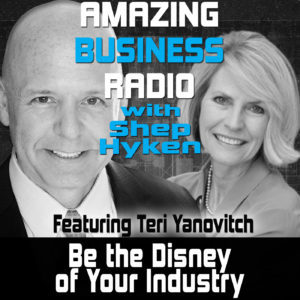
Be the Disney of Your Industry
Lessons from Disney to Improve Your Customer and Employee Experiences
Shep Hyken interviews Teri Yanovitch. They discuss her experience as a Disney employee, their hiring process, and the customer service takeaways that can be applied to any organization in any industry.








Top Takeaways:
It’s neither luck nor magic that creates success (though those can certainly help)—it’s hard work. Any and every company is capable of putting in hard work.
Give potential employees a taste of your company’s culture right away. Be upfront about the requirements of the position and the expectations for success. This will help eliminate candidates who may not be the best fit.
During the candidate’s interview, don’t ask all the questions. Allow the applicant to ask questions of you and your company. This helps them feel they are a part of the company and the culture from day one.
Be transparent as you describe the job. New employee orientation should reinforce all the information applicants already heard during the hiring process. It should be a way of further introducing them to the company culture and holding them accountable for previously established expectations.
Details are what create value for customers, especially throughout multiple points of contact. Paying attention to detail throughout every stage of the customer journey is what will ultimately amaze them.
Think through the entire customer experience from every angle. More companies need to consider the customer journey in its entirety.
Leadership must demonstrate the behaviors they want to see in their employees, even for something as simple as picking up trash. When leadership models behavior, it spreads throughout the entire organization.
Don’t forget that there is an internal customer experience in addition to the external customer experience. This is also known as the employee experience, and it is just as important as the external customer experience. Happy employees create happy customers.
Create your company’s “Service Standards.” Then, ensure that these standards are consistent across every location and every individual. That will create amazement for the customer.
Never stop training, even on “the basics.” It is the consistency that creates the magic.
Quotes:
“The key to success is recognizing that there is a ripple or domino effect to internal service. Happy employees create happy customers.”
“Any organization can apply these Disney lessons by paying attention to the details, by recognizing that internal service is just as important as external service, and by making sure that everybody knows the expectations. Start sharing those expectations in the interview process and reinforcing them in your orientation.”
“You don’t have to be a theme park or have characters in order to be immensely successful. You, too, can be a successful organization in your industry.”
About:
Teri Yanovitch is a dynamic speaker, author, trainer and consultant. Her passion is helping organizations create a culture of service excellence.
Shep Hyken is a customer service and experience expert, New York Times bestselling author, award-winning keynote speaker, and your host of Amazing Business Radio.
The post Amazing Business Radio: Teri Yanovitch appeared first on Shep Hyken.
February 24, 2020
5 Top Customer Service Articles For the Week of February 24, 2020
Each week I read a number of customer service and customer experience articles from various resources. Here are my top five picks from last week. I have added my comment about each article and would like to hear what you think too.
Customer service drives loyalty for Amazon-owned Zappos by Tabitha Cassidy
(Digital Commerce) The recently revamped VIP program Zappos launched has helped the Amazon-owned retailer build stronger customer loyalty and increase conversion.
My Comment: What drives loyalty? Is it a loyalty program with incentives to come back? Or, is it the experience? At Zappos it’s simple… It’s the experience. Easy to do business with, fast delivery and easy returns. The experience is a big part of their marketing.
The Next Big Thing in Customer Experience: Frictionless Returns by Poornima Apte
(SmarterCX) The Amazon-Kohl’s partnership exemplifies the next frontier in eCommerce where retailer attention is shifting to returns as a way of delivering an outstanding customer experience.
My Comment: As long as we just mentioned Zappos, let’s talk about Amazon (who owns Zappos). Once again, it’s the service that is helping to drive their loyalty. The Amazon-Kohl’s partnership has helped make returns easy and quick. While you may or may not be a retailer, the thinking behind their customer-focused solutions is something everyone should study.
Use Amazon’s Practice of “Working Backwards” to Completely Transform How You Work by Justin Bariso
(Thrive Global) Learn how the process works and how it can help you and your business.
My Comment: Okay… I promise this is my last article mentioning Amazon for this week, but I love this premise. According to the author, Amazon’s strategy is to think backward. According to Amazon’s Ian McAllister, working backward begins by “[trying] to work backward from the customer, rather than starting with an idea for a product and trying to bolt customers onto it.” In other words, start with the end in mind. This works for virtually any business.
2020 Predictions For Marketing And Customer Experience by Mark Floisand
(Forbes) Working as chief marketing officer of an AI-based business and marketing solutions company, I have a unique viewpoint of the marketing industry and the evolutions taking place, which has led me to make the following predictions for the year ahead.
My Comment: We’re almost to the end of February and there are still articles coming out with predictions for 2020. Personally, I like them – and especially this article. Everything from privacy to technology to personalization and more is covered in this article. There’s even an interesting prediction about how this year’s elections are changing the way customers think about how they like doing business with a company.
Customers Flock To Brands That Display Exceptional Customer Service by Athina Mallis
(WHICH-50) The 2019 NICE inContact Customer Experience (CX) Transformation Benchmark study captured and compared the attitudes of 2550 consumers in the US, UK and Australia. The report confirms the importance of customer service on the companies’ bottom line.
My Comment: It should come as no surprise that people like doing business with the companies and retailers that treat them right – as in good customer service. This article pulls some of the compelling stats and facts from the Nice inContact Customer Experience Transformation Benchmark study. Worth a quick read and you may want to consider downloading the full report.
 Shep Hyken is a customer service expert, professional speaker and New York Times bestselling business author. For information on The Customer Focus
Shep Hyken is a customer service expert, professional speaker and New York Times bestselling business author. For information on The Customer Focus customer service training programs go to www.TheCustomerFocus.com. Follow on Twitter: @Hyken
customer service training programs go to www.TheCustomerFocus.com. Follow on Twitter: @Hyken
The post 5 Top Customer Service Articles For the Week of February 24, 2020 appeared first on Shep Hyken.
February 21, 2020
Guest Post: 5 Strategies for Mastering Customer Experience at the Point of Sale
This week we feature an article by Mathew Cooper, a Content Marketing Head at POS Plaza. He shares tactics to help ensure a point-of-sale system will enhance the customer experience.
In today’s highly competitive and constantly advancing retail industry, there is no place for ordinary customer service. Modern consumers are smart – they have countless shopping options, and thus are too impatient for checkout delays, long queues and incompatible payment options. They demand a seamless shopping experience to convert from a regular shopper to a loyal customer.
Right from the time a customer enters your retail store, you will find several opportunities and areas – from product range to product display and marketing, to prove how and why your business is better than others. POS (point of sale) or POP (point of purchase) – a place where customer orders and payments are processed, makes one of the most significant parts of the customer experience.
Keeping that in mind, this blog highlights the best strategies you can implement to master customer experience at the point of sale. But before we delve into those guidelines, let’s first understand why POS is so crucial for a retail business.
Why Point of Sale Matters So Much?
It’s the most common spot for shoppers to abandon their cart.
Cart abandonment is a nightmare for any retailer – online or offline. Payment processing delays, long queues and confusion related to product or payment at the checkout, can quickly escalate into a lost customer and revenue.
It’s the mainstream interaction hub.
Regardless of whether or not you have dedicated salespeople posted at the point of sale, your customers will certainly involve in some sort of interaction. Even if it’s with some automated software instead of human, customer interaction at the checkout point is an opportunity to improve customer engagement and brand reputation.
It’s the last impression of your store on the customer.
Retailers mostly focus on first impressions as they hold utmost importance but know that last impressions are as imperative. The point of sale of your store is your last chance to make sure the customer takes away a memorable shopping experience from your store which is worth bragging about.
It’s a foundation for repeat purchases.
Most shoppers will have questions and concerns regarding products, purchases, sale, offers etc. and the point of sale is their last medium to get them addressed. Be sure to make your customers feel comfortable enough to raise the queries they have in mind while giving them direct, honest answers. This will create a sense of trust and loyalty, encouraging the customer to visit again.
It’s the last opportunity to distinguish yourself from your competitors.
Though you will certainly have a lot of chances to set yourself apart from the crowd once the customer is inside your store, the point of sale will be the last one and probably the biggest one. Utilize your best resources and strategies to ensure a smooth checkout and maximum customer satisfaction. Give customers a reason why they should keep coming back to you rather than exploring other stores.
What Can You Do to Improve customer experience at POS?
1. Ensure the right hardware and software in place
First things first – get your POS suite right. With endless choices of retail POS systems in the market, deciding what will work best for your business can be overwhelming. The first step to choosing the most appropriate solution is defining your needs, priorities and in-store challenges you need to address, in advance. Once in the know about your needs, it would be easier to boil down your choices to a platform that is best suited to your business.
2. Train Your Staff
A great POS solution will be of no use if you don’t have the right people to operate it. Proper staff training is crucial to the success of POS integration into a retail business. Use video tutorials and illustrated documentation to help your employees understand the functioning of POS system. Teach them how they can utilize POS data to better handle customer interactions and create personalized experiences. Also make sure that your staff is aware of your store policies related to purchases and transactions so that they can provide quick and seamless service to customers.
3. Integrate Multiple Payment Gateways
As mentioned earlier, customers these days demand a smooth, quick and convenient payment at retail stores. That said, your POS system should be able to accept different forms of payment – cash, credit/debit card, PayPal, Apple Pay etc. – to make sure you don’t lose a customer and revenue at the last stage of a purchase.
4. Utilize Data
A key feature of an advanced POS system is to capture data about customers and their shopping behavior. When equipped with comprehensive insights about your customers and their purchases, you will be able to take informed decisions about your inventory and prevent problems like stockout and excessive stock. POS data also allows you to create personalized marketing campaigns to tap into your customers’ interests and generate more sale.
5. Speed Up Your Tasks
Waiting on the table for the bill to arrive can turn any enjoyable dining experience into a frustrating ordeal. The same goes for an otherwise excited customer waiting in a long queue to get their payment processed. An advanced POS system allows you to optimize the checkout process and eliminate any delays in payment. A faster, more streamlined checkout will also help your business itself by enabling your staff to process more orders in a shorter amount of time and generate more profit.
The Takeaway
The right POS solution can unlock a more satisfying and enjoyable experience for your customers by simplifying the checkout process, enabling staff to be more accurate and efficient and allowing you to run personalized promotions and offers.
The aforementioned strategies, on the other hand, will help you maximize customer engagement and satisfaction at POS while ensuring long-term success for your retail business.
Mathew Cooper is a Content Marketing Head at POS Plaza, a reputed online dealer of POS solutions and supplies in Australia. Mathew is involved in developing highly researched and engaging posts about everything POS.
F
 or more articles from Shep Hyken and his guest contributors go to customerserviceblog.com.
or more articles from Shep Hyken and his guest contributors go to customerserviceblog.com.
Read Shep’s latest Forbes article: Fraud Is Eroding The Customer Experience
The post Guest Post: 5 Strategies for Mastering Customer Experience at the Point of Sale appeared first on Shep Hyken.
February 19, 2020
The Cult of Amazement
In the updated and revised edition of The Cult of the Customer, I cover the concept of amazement. This may be old news to my followers, but it is worth repeating.
Amazement does not come from a WOW or over-the-top experience. Those happen on occasion, especially when problems are handled well. But on a day to day basis, amazement happens when you deliver experiences that are consistently and predictably above average. They could even be just a tiny little bit above average. What makes that amazing is that it is always predictable. The customer owns it because they know it’s going to happen.
What happens when there’s a problem or complaint? That’s not amazing at all. At that moment, the customer slips from amazement back to uncertainty. This is where the customer begins the first time they do business with you. They are uncertain as to what will really happen. Even if you have a great reputation for delivering an amazing customer experience, they haven’t yet experienced that yet, so they can’t know for sure. The first time they have a problem with you, even after a series of great experiences, all they can do is hope you will handle it well. Until it’s proven, the customer remains in that state of uncertainty.
However, once you handle the problem well, you and your organization shoot right back into amazement. Hopefully problems do not happen often, but when they do, the customer needs to know that they can count on you. If they do, they will stay in that Cult of Amazement even if there is a problem.
No person or company is perfect. Mistakes will be made. Problems will impact the customer’s experience, regardless of whose fault they are. How they are handled makes all the difference. This isn’t anything you don’t already know, but you must keep in mind that an unresolved or mishandled problem will cast doubt and uncertainty in the customer’s mind.
The Cult of Amazement is all about consistent and predictable experiences. As an example, you want your customers to say the following about you: “They are always so helpful and knowledgeable. Even when there is a problem, I can always count on them.” The word always followed by something positive is the key. When it’s used in a positive way related to a problem or complaint, you know you’re in the Cult of Amazement!
Shep Hyken is a customer service expert, keynote speaker, and New York Times bestselling business author. For information, contact 314-692-2200 or www.hyken.com. For information on The Customer Focus customer service training programs, go to www.thecustomerfocus.com. Follow on Twitter: @Hyken
customer service training programs, go to www.thecustomerfocus.com. Follow on Twitter: @Hyken
(Copyright © MMXX, Shep Hyken)
The post The Cult of Amazement appeared first on Shep Hyken.
February 18, 2020
Amazing Business Radio: Claire Sporton
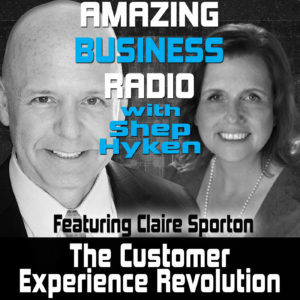
The Customer Experience Revolution
How to Fish the “Big Data Lake” for Customer Experience Insights
Shep Hyken interviews Claire Sporton. They discuss the importance of investing in the customer experience and how CX professionals can communicate that need with leadership and executives.








Top Takeaways:
It isn’t enough to simply gather data. Data collection without action is a waste of time. You must use those insights to drive positive change within your organization.
Learn how to “fish the big data lake” so you can pull out useful pieces of information about your organization, its processes, and the customer experience. It is crucial to be able to determine what is important and what is not.
Customers want and expect a personalized experience. Microdata is specific to an individual person and can help you deliver the personalized experience that customers want.
Consumers want to do business with organizations they trust. Trust is about setting expectations and delivering on those expectations. The first step in any customer relationship should be about building that trust.
Confirmit’s recent report indicates that a very small number of businesses expect their investment in CX to increase in 2020. This is in spite of the fact that improving CX can lead to more success for businesses overall.
Instead of thinking about ROI, instead, think of ROX—return on experience. You must be able to demonstrate this in tangible terms relating to company goals that executives can immediately connect to.
Improving your NPS rating alone will not necessarily lead to an increase in sales. You must examine the operational side of your business and either eliminate or mitigate problems that get in the way of improvement.
Technology can be a powerful tool in creating change, but it is not a solution by itself. There must always be a human element to assist, support, and create a connection.
Quotes:
“Our expectation as consumers is that the organizations we work with know us and know what we want.”
“Consumers want to do business with organizations that they trust. Trust is about setting expectations. Tell people what you’re going to do and then deliver exactly as expected. Build trust by meeting expectations day in and day out across all touchpoints.”
“You must demonstrate the ROI of customer experience. It’s not good enough to just say that this is the right thing to do. You must have the business acumen to speak in terms of your organization’s leadership understands.”
“As customer experience and customer service practitioners, we must align with the overall business strategy. Help leadership understand how we can help them hit those targets.”
About:
Claire Sporton is the Senior Vice President of Customer Experience Innovation at Confirmit, a leading SaaS vendor for multi-channel customer experience, employee engagement and market research solutions.
Shep Hyken is a customer service and experience expert, New York Times bestselling author, award-winning keynote speaker, and your host of Amazing Business Radio.
The post Amazing Business Radio: Claire Sporton appeared first on Shep Hyken.
February 16, 2020
5 Top Customer Service Articles For the Week of February 17, 2020
Each week I read a number of customer service and customer experience articles from various resources. Here are my top five picks from last week. I have added my comment about each article and would like to hear what you think too.
10 Ways To Provide a Cutting-Edge Retail Customer Experience by Janelle Estes
(Street Fight) What does that look and feel like? Here are 10 examples of best practices that represent the state of the art in retail CX.
My Comment: Don’t be fooled by the word “Retail” in the title. While the article does focus on Customer Experience strategies for retail, many are also applicable to B2B – or any type of organization. I’m sure the Instagram strategy won’t appeal to most B2B’s, but there’s still plenty of good ideas to consider.
Top 5 B2B Customer Experience (CX) Best Practices for 2020! by Lipi Khandelwal
(Martech Advisor) This article unveils the top 5 B2B customer experience (CX) best practices for 2020.
My Comment: And, for those that still felt the first of my Top Five roundup was too retail focus, along comes this article that’s all about CX and B2B. Here are some important reminders for us to consider, starting with creating your Customer Journey Map. (I’m still surprised at the number of businesses that haven’t even created their JM.)
Predictive AI and Customer Experience: What’s Next? by Benjamin Hunting
(SmarterCX) Artificial intelligence has already impacted the customer experience across a wide range of industries. Although the workings are mostly transparent, with the data analysis AI is commonly leveraged for occurring largely behind the scenes, for some services, the effect is front and center.
My Comment: This is a VERY short article that introduces us to the concept of “Predictive Personalization.” Consider that Amazon makes suggestions about what you’ll purchase next based on your buying history. Or that Netflix makes suggestions based on what you’ve watched in the past. Beyond sales suggestions, we’re seeing this pop up in suggestions for maintenance, upgrades and more.
How to Avoid Providing a Bad Customer Experience by Rieva Lesonsky
(Small Business Trends) Ready to win back a customer after a bad customer service complaint? It may already be too late.
My Comment: Some surveys say that a customer will switch to another brand after just one bad experience. The stakes are higher than ever. Here is a shortlist of seven “exasperating” customer service turn-offs, with a few suggestions on what it takes to keep your customers coming back.
How to Run a Successful Customer Advisory Board Program: 5 Proven Tips by Rob Jensen
(CMSWire) For marketers who are interested in gathering more impactful, strategic input from customer executives, customer advisory boards (CABs) are the proven way to uncover such valuable feedback. Such insights here can include developing entirely new products or services, new markets and customer segments to target, and partner and M&A candidates.
My Comment: Giving your customer a “seat at the table” is an underutilized strategy. Yet consider taking it to the next level, going beyond just a seat and inviting a number of customers to build out your Customer Advisory Board? If you’re truly interested in what customers have to say, don’t just keep one seat open. Give them the entire table!
BONUS
16 Inspiring Customer Service Quotes To Swear by Krishna Charan
(Freshdesk) We have compiled a set of great customer service quotes, from which you can consume as quick thought leadership lessons on delighting customers. These quotes about customer service will help you realize the huge positive impact you’re making on the daily lives of customers and the success of your organization.
My Comment: I always enjoy inspirational and motivational quotes, especially when they are focused on customer service and CX. Here’s an A-Z (Amazon to Zappos) list of quotes from many recognizable (and not so recognizable) experts. I’m honored that FreshDesk included one of my quotes on this list.
 Shep Hyken is a customer service expert, professional speaker and New York Times bestselling business author. For information on The Customer Focus
Shep Hyken is a customer service expert, professional speaker and New York Times bestselling business author. For information on The Customer Focus customer service training programs go to www.TheCustomerFocus.com. Follow on Twitter: @Hyken
customer service training programs go to www.TheCustomerFocus.com. Follow on Twitter: @Hyken
The post 5 Top Customer Service Articles For the Week of February 17, 2020 appeared first on Shep Hyken.
February 14, 2020
Guest Post: Customer Focused Leadership
This week we feature an article by Sean Spurgin, Director of Learning Design at Blue Sky. He discusses how to create a customer experience focused culture in the workplace.
What if we said there were nine things that great leaders do to create a custom focused culture? Well, we’ve distilled the magic down to just nine things that leaders can do to create the climate for customer experience to thrive. Here’s the top three highlights of those nine things.
In these turbulent times, customer experience has never been higher on everybody’s agenda. There isn’t an organization we talk to that isn’t trying to either be number one for service, or beat the competition around service, or just improve the customer experience. In fact, if you were to ask 500 leaders to put up their hands if service is on their agenda, 500 leaders would put up their hands.
What’s quite interesting about that is if you follow the ICS top 10 for service and all of the surveys and all the industry data that tells us who’s good at this, largely it’s the same organizations that are rising to the top every time. So, the big question is – why? If the Holy Grail is excellent customer experience, why is it so hard for anybody else to achieve it?
There is a leadership gap around service culture.

What is often seen in organizations is a leadership team at the top with perfectly good intent – after all everybody wants to drive a better service culture in their organization. But good intent isn’t enough. There may be a really good compelling story or vision, maybe a good set of service principles and standards, but those things alone won’t translate in to an engaging, effortless and human experience across every customer channel. If it were that simple, companies could all just slap up a few posters on the wall, sit back and wait for the awards and accolades to flood in. But it’s not. The more challenging part for any organization is to create the climate within which a fabulous customer experience shows up and thrives every day. If you ask operational managers and heads of businesses to define a great service experience, they will always go to the end experience. They’ll go to Amazon’s brilliantly simple ‘one click’ buying experience or the ‘freedom to do exactly what’s right for the customer’ of John Lewis. But when you ask them what it is those organizations DO on the inside to create those experiences, there’s a tumble weed moment.
There’s a leadership gap between intent and action, not knowing what leaders need to actually do to create a cultural climate for customer experience to thrive. And even then, with the answer in the palm of their hand, being prepared to systematically and consistently “do” the activities that the best service companies embrace every day, every week, every month and every year.
 One of the first things to be really clear about is what good looks like in the new economy. Most organizations have understood in today’s world that customers want everything now, and they want it overnight. There’s a new kind of customer emerging who doesn’t want just polite, professional and friendly (although that would a be a good place to start). In the new economy, it’s all about human and effortless experiences, and the ‘soft skills’ of the past simply won’t cut it. Let me give you an example. Where empathy used to be the buzz word, we are finding that advocating – a clear demonstration that I am on your side and you are safe in my hands – has a much bigger impact on how customers feel about the conversation.
One of the first things to be really clear about is what good looks like in the new economy. Most organizations have understood in today’s world that customers want everything now, and they want it overnight. There’s a new kind of customer emerging who doesn’t want just polite, professional and friendly (although that would a be a good place to start). In the new economy, it’s all about human and effortless experiences, and the ‘soft skills’ of the past simply won’t cut it. Let me give you an example. Where empathy used to be the buzz word, we are finding that advocating – a clear demonstration that I am on your side and you are safe in my hands – has a much bigger impact on how customers feel about the conversation.
Another example is in the science of the ‘peak end rule,’ where an experience is ended in a more memorable and human way than just ‘is there anything else I can help you with?’.
There are many more examples, and companies that are waking up to this new experience paradigm and are designing their service strategies and service principles around this low effort, loyal experience, are the ones that really get customers coming back. Now let’s move on to VDAs – visible demonstrable actions. These are things that leaders do in customer focused cultures that are visible to people within the organization and demonstrate a clear commitment to customer and people. For example, in one organization we know, everyone – irrespective of role or level – takes customer calls every month. It’s a demonstration that we’re all here for the customer. In another, the higher up the food chain you go, the further away from the building leaders park, reinforcing the principle that those people who need to be ready to serve customers need to have access to the building more quickly than everybody else.
So, all the leaders have to go to the park and ride and the frontline teams get to park next to the building. A few organizations are now adopting a ‘people board member’ approach where anyone in the business can get a seat at the board room table with equal voting rights and access to information as everyone else. These are symbolic demonstrations of a commitment to customer and people. And if you talk to a leadership team and ask “what are yours?”, if they even have to pause and hesitate to think of what they are, they probably don’t exist. So, a big way to drive a culture that’s focused on customer is to have clear, visible, demonstrable actions that leaders do, that people in the business can describe and that demonstrate commitment to customer. Then, there are clear things that best for service businesses do to create a permission culture where front line teams are empowered to ‘do the right thing’ in the moment for customers. The Zappos or John Lewis effect doesn’t just show up by chance. Process will only account for eighty to ninety percent of what’s required in a job – it’s the ten to twenty percent of grey, in a given situation, where something different needs to be done, that makes the difference.
 Everyone needs to understand what levels of permission truly exist. It’s no use pointing at your front line teams and saying ‘you are empowered.’ That’s not it. Empowered cultures are founded on the stories that exist in the business that bring to life the expectation, the standard, the degrees to which you are allowed to go and the applauded moments where we went the extra mile. You can’t write process for permission, the possibilities are infinite. But best for service companies gather, share and write down the examples of where people have stepped out of process, within the boundaries, and everybody says “that’s the level of empowerment we want in this team”.
Everyone needs to understand what levels of permission truly exist. It’s no use pointing at your front line teams and saying ‘you are empowered.’ That’s not it. Empowered cultures are founded on the stories that exist in the business that bring to life the expectation, the standard, the degrees to which you are allowed to go and the applauded moments where we went the extra mile. You can’t write process for permission, the possibilities are infinite. But best for service companies gather, share and write down the examples of where people have stepped out of process, within the boundaries, and everybody says “that’s the level of empowerment we want in this team”.
Then they get busy encouraging the ecosystem to develop, supporting leaders and managers to be brilliant at coaching judgement and continually updating the story book with new examples every day. Perhaps one of the single biggest influencers of a customer focused culture is the extent to which people are encouraged to BE customer focused every day.
Of course, firstly everyone in the business need to be clear on what good looks like. But once you are clear, it then becomes largely about how you get people to rock up and do good things for customers in every single interaction.
Sadly, in society we’ve got a bit of an epidemic of negative critique so people are always homing in on the “what you didn’t do” or “what wasn’t supposed to be” rather than focusing on the good stuff, the stuff that is already showing up and dazzling customers. In a well-known delivery company, the CEO takes time every month to spot the clean and sparkly vans representing his brand out on the road, take a selfie next to it and send it on to the depot manager with a thumbs up and a note of praise for the driver.
By comparison, the CEO of a retail bank has spent the past few years spotting dirty ATM machines, taking a photo and emailing the evidence to the Branch Manager. In the end, you have to decide as a leader which of these approaches you will adopt. Are you the one that’s going to catch people doing it right, or point the finger at the one’s doing it wrong? Because if you want to be a best for service business, these are some of the things that really matter.
Blue Sky Performance Improvement are experts in behavior change that is proven to drive return on investment. They have trained more than 350,000 people worldwide and have a passion for making the world a little more human, through improving organizational culture and customer experience.
F
 or more articles from Shep Hyken and his guest contributors go to customerserviceblog.com.
or more articles from Shep Hyken and his guest contributors go to customerserviceblog.com.
Read Shep’s latest Forbes article: Marketing Doesn’t Fix What’s Broken
The post Guest Post: Customer Focused Leadership appeared first on Shep Hyken.
February 12, 2020
The Worst Thing That Happens Is Your Customer Loves You
What if the worst thing a customer ever said about you was, “I love you!”?
Even on a bad day, you’re still so good that they love you! Are you that good? Do customers love you even when there’s a problem or complaint? Here are six ways to make customers love you no matter what!
Become customer-focused. This means that in addition to creating an amazing customer experience, every decision keeps the customer in mind. It doesn’t mean every decision will make the customer happy, but the customer is always kept in mind when any type of change is made, from price to changes in features to new and even discontinued products.
Be transparent. As you make customer-focused decisions, even ones that might negatively impact the customer, let the customer know ahead of time—and let them know why you’re making the decision. Customers appreciate knowing and understanding when and why something changes.
Manage problems and complaints. This is where “the rubber hits the road,” as the old saying goes. You could provide a flawless experience for ten years, which your customer loves you for. But one day there’s a problem. This is judgement day. This is where you earn the right to do business with them for the next ten years.
Customers are not always right. This comes from my older material, but it’s worth mentioning again. The customer is NOT always right! But they are always the customer. Whenever they are wrong, let them be wrong with dignity and respect.
Avoid transactions. A transaction is a one-time occurrence. An interaction is a relationship that is ongoing. Customers love to feel like they’re part of something. The way to make that happen is to think of them not as a customer, but as a partner. This is a powerful B2B strategy, but it works with something as simple as buying shoes. The salesperson doesn’t sell a shoe. Instead, they sell comfort, style and emotion. They understand what the customer wants, not just what they say they need. It’s more than a sale. It’s part of something that is bigger and ongoing.
Aim for always and forever. Let’s close these customer love tips with one final thought. I’ve written about this extensively, but this is where you want to be. You want your customers to describe you using the word always before something positive. For example, “They always respond quickly,” or, “They are always so helpful.” Reflecting back on number three (managing complaints), they could say, “Even when there is a problem, I can always count on them.” The word always is… always and forever!
There you have it—six ways to make your customers love you. Just in time for Valentine’s Day! Consider showing your customers a little extra love this Valentine’s Day—or any day of the year—by focusing on one of these six ideas. I guarantee it will make your customers love you back.
Shep Hyken is a customer service expert, keynote speaker, and New York Times bestselling business author. For information, contact 314-692-2200 or www.hyken.com. For information on The Customer Focus customer service training programs, go to www.thecustomerfocus.com. Follow on Twitter: @Hyken
customer service training programs, go to www.thecustomerfocus.com. Follow on Twitter: @Hyken
(Copyright © MMXX, Shep Hyken)
The post The Worst Thing That Happens Is Your Customer Loves You appeared first on Shep Hyken.

